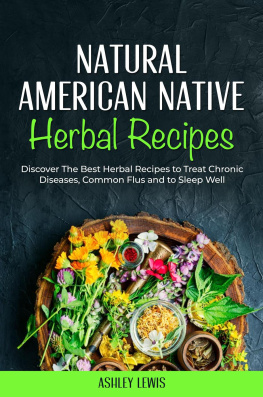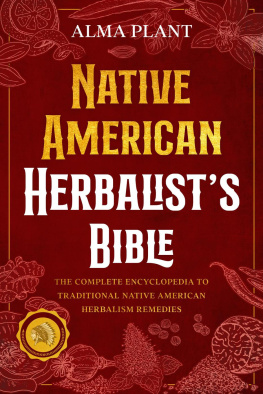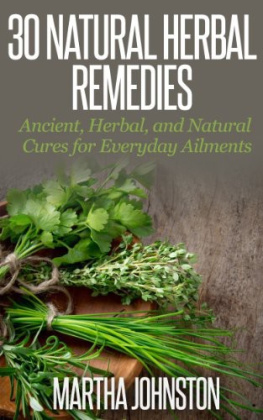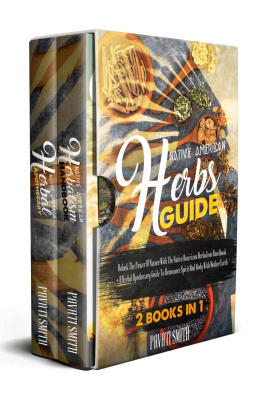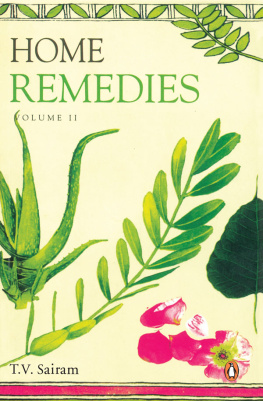Native American Herbalism
encyclopedia
Traditional Herbal Remedies & Recipes
To Heal Common Ailments
Brenda Amadahy
Copyright 2020 Brenda Amadahy - All rights reserved.
The content contained within this book may not be reproduced, duplicated or transmitted without direct written permission from the author or the publisher.
Under no circumstances will any blame or legal responsibility be held against the publisher, or author, for any damages, reparation, or monetary loss due to the information contained within this book. Either directly or indirectly.
Legal Notice:
This book is copyright protected. This book is only for personal use. You cannot amend, distribute, sell, use, quote or paraphrase any part, or the content within this book, without the consent of the author or publisher.
Disclaimer Notice:
Please note the information contained within this document is for educational and entertainment purposes only. All effort has been executed to present accurate, up to date, and reliable, complete information. No warranties of any kind are declared or implied. Readers acknowledge that the author is not engaging in the rendering of legal, financial, medical or professional advice. The content within this book has been derived from various sources. Please consult a licensed professional before attempting any techniques outlined in this book.
By reading this document, the reader agrees that under no circumstances is the author responsible for any losses, direct or indirect, which are incurred as a result of the use of information contained within this document, including, but not limited to, errors, omissions, or inaccuracies.
Table Of Contents
Introduction
T oday we are used to consuming ready-to-use products, which we consider practical and "convenient," while in the past - not too far if you think about it - it was normal to produce and process natural resources ourselves in order to use them. The human being used to produce and not just consume, was always in contact with nature and therefore knew how to recognize the cycles of the seasons, predict natural disasters and even distinguish the various moments of the day without the need to use a watch. In addition, he knew his own body and knew how to cure "diseases" in a natural way, mainly through the use of herbs.
Of course, consuming ready-made products saves a lot of effort and the time gained in this way can be used to do other things - such as studying, having fun, traveling... But the biggest problem of the contemporary human being is that in the end he has lost contact with Nature and His True Nature, and has ended up locking himself in small or large "golden prisons" where he has less and less time to devote to his interests and relax. In fact, in recent years there is a sort of "return to ancient traditions" as far as food and care is concerned because it has been discovered that the massive use of inorganic chemicals, pollution produced by consumerism, daily ingestion of dead food and stress bring misery, disease, suffering and even death .
We are in a very interesting historical period: on the one hand we are in love with technology and we want more and more of it, but on the other hand we feel the desire to lead a fuller and more satisfying life, above all we want to understand the causes of suffering and illness to allow us to live happy and healthy lives. The answer could be halfway between technology and the ancient knowledge of our ancestors who teach us to live in harmony with the Planet - not by making war on those who find themselves oppressed but by acting in a way that allows people to free themselves from the chains and join new initiatives (and not "old" initiatives disguised as "new"). The science that now finds more and more space in our lives is HERBALISM, linked to other sciences such as Botany and Biochemistry. Without forgetting Naturopathy, Osteopathy, Chiropractic and the many other sciences that are linked to each other - even if they have all been "disconnected". Modern medicine is the daughter of all these sciences.
However, it must be said that healing must be holistic, i.e. it must take into account the cause that triggered the disease (emotional/social problems/ trauma/exposure to harmful radiation/ intoxication / poor diet, ...) and treat the person at 360 degrees, i.e. at the emotional, mental, spiritual and physical level. Otherwise the treatment will be incomplete and could even be harmful. Due to the vastness of the topic, this book will be addressed in 2 separate parts. The first part will be theoretical and practical insights into herbalism and the introduction of natural healing in our lives. The second part will be a detailed encyclopedia of beneficial plants to be used to heal our body. Good reading.
Chapter 2:
Herbalism
H erbalism is a branch of botany that is mainly concerned with studying the leaves of plants. Herbalism or herbalism is in short the use of herbs for their therapeutic and medicinal value. In fact, herbs contain a wide variety of chemicals that act on the body helping it to regain its balance.
The use of medical herbs is as old as the world, and it is certain that our ancestors were cured in this way. Even animals (both carnivores and vegetarians) take herbs periodically or when they are sick: if, for example, you observe a cat living outdoors you will notice that practically every day, between meals, it eats a particular type of herb (not only the famous catnip) that promotes digestion and purifies the body from worms.
Even some of our knowledge about herbs comes from the observation of the behavior of animals when they are sick or when they have been attacked or injured by other animals, in fact they instinctively know how to recognize and find the best herbs to cure themselves and avoid the poisonous ones.
We humans have also learned by mistakes: in this way we have understood which plants can be used as food, which ones are poisonous, and which ones are medicinal, i.e. make changes in our body. Then there are plants that cause hallucinations, addiction and cloud the senses and therefore are real drugs. All this knowledge has been passed on and enriched orally from generation to generation, and each culture in the world has developed its own plant science and tradition.
History Of Herbalism
The first written testimony of the use of the medicinal herbs goes back to about 5000 years ago, work of the Sumerians, inhabitants of Mesopotamia (today Iraq). The knowledge of the Sumerians, as we have already seen in previous articles, derives very probably from other evolved civilizations of which we have lost every trace. In Ancient Egypt the Goddess Isis was called the "goddess of health" because she was considered the one who transmitted to her people the secrets of Nature and taught to heal diseases.
In fact, according to tradition it was Isis who explained to their ancestors how to cultivate and use medicinal herbs and edible plants such as wheat and barley, and even the production of rare and precious wines. From 305 B.C. until 30 B.C. Egypt was under the rule of the Ptolemaic dynasty (which owes its name to its founder Ptolemy Sotere), who founded a Medical School near Alexandria. The most famous professors of this school were Erasistratus, ancient Greek anatomist, and Ephilos, Greek-Hellenistic anatomist and doctor. Both professors had the opportunity to dissect the corpses of criminals put to death that the government made available to them. It seems that both Erasistratus and Erofil were firmly opposed to bloodletting and poisonous medicinal remedies, preferring instead herbs easily found in nature.







